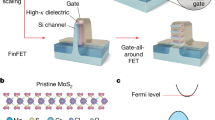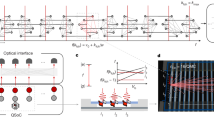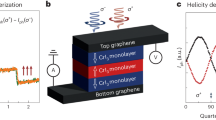Abstract
In-memory computing provides an opportunity to meet the growing demands of large data-driven applications such as machine learning, by colocating logic operations and data storage. Despite being regarded as the ultimate solution for high-density integration and low-power manipulation, the use of spin or electric dipole at the single-molecule level to realize in-memory logic functions has yet to be realized at room temperature, due to their random orientation. Here, we demonstrate logic-in-memory operations, based on single electric dipole flipping in a two-terminal single-metallofullerene (Sc2C2@Cs(hept)-C88) device at room temperature. By applying a low voltage of ±0.8 V to the single-metallofullerene junction, we found that the digital information recorded among the different dipole states could be reversibly encoded in situ and stored. As a consequence, 14 types of Boolean logic operation were shown from a single-metallofullerene device. Density functional theory calculations reveal that the non-volatile memory behaviour comes from dipole reorientation of the [Sc2C2] group in the fullerene cage. This proof-of-concept represents a major step towards room-temperature electrically manipulated, low-power, two-terminal in-memory logic devices and a direction for in-memory computing using nanoelectronic devices.
This is a preview of subscription content, access via your institution
Access options
Access Nature and 54 other Nature Portfolio journals
Get Nature+, our best-value online-access subscription
$29.99 / 30 days
cancel any time
Subscribe to this journal
Receive 12 print issues and online access
$259.00 per year
only $21.58 per issue
Buy this article
- Purchase on Springer Link
- Instant access to full article PDF
Prices may be subject to local taxes which are calculated during checkout




Similar content being viewed by others
Data availability
The authors declare that the main data supporting the findings of this study are available within this article and its Supplementary Information. Source data are provided with this paper. Extra data are available from the corresponding authors upon request.
Code availability
The data analysis of conductance measurements was performed using our open-source code XME analysis, which is available at https://github.com/Pilab-XMU/XMe_DataAnalysis. The computation details can be made available from the corresponding authors upon request.
References
Ielmini, D. & Wong, H. S. P. In-memory computing with resistive switching devices. Nat. Electron. 1, 333–343 (2018).
Yu, S. Neuro-inspired computing with emerging nonvolatile memorys. Proc. IEEE 106, 260–285 (2018).
Yang, J. J., Strukov, D. B. & Stewart, D. R. Memristive devices for computing. Nat. Nanotechol. 8, 13–24 (2013).
Borghetti, J. et al. ‘Memristive’ switches enable ‘stateful’ logic operations via material implication. Nature 464, 873–876 (2010).
Strukov, D. B., Snider, G. S., Stewart, D. R. & Williams, R. S. The missing memristor found. Nature 453, 80–83 (2008).
Zhang, W., Mazzarello, R., Wuttig, M. & Ma, E. Designing crystallization in phase-change materials for universal memory and neuro-inspired computing. Nat. Rev. Mater. 4, 150–168 (2019).
Grollier, J. et al. Neuromorphic spintronics. Nat. Electron. 3, 360–370 (2020).
Guo, R., Lin, W., Yan, X., Venkatesan, T. & Chen, J. Ferroic tunnel junctions and their application in neuromorphic networks. Appl. Phys. Rev. 7, 011304 (2020).
Cho, B. et al. Rewritable switching of one diode-one resistor nonvolatile organic memory devices. Adv. Mater. 22, 1228–1232 (2010).
Cho, B., Song, S., Ji, Y., Kim, T.-W. & Lee, T. Organic resistive memory devices: performance enhancement, integration, and advanced architectures. Adv. Funct. Mater. 21, 2806–2829 (2011).
Busche, C. et al. Design and fabrication of memory devices based on nanoscale polyoxometalate clusters. Nature 515, 545–549 (2014).
Goswami, S. et al. Charge disproportionate molecular redox for discrete memristive and memcapacitive switching. Nat. Nanotechol. 15, 380–389 (2020).
Han, Y. et al. Electric-field-driven dual-functional molecular switches in tunnel junctions. Nat. Mater. 19, 843–848 (2020).
Goswami, S. et al. Decision trees within a molecular memristor. Nature 597, 51–56 (2021).
Lörtscher, E., Ciszek, J. W., Tour, J. & Riel, H. J. S. Reversible and controllable switching of a single‐molecule junction. Small 2, 973–977 (2006).
Li, H. B., Tebikachew, B. E., Wiberg, C., Moth-Poulsen, K. & Hihath, J. A memristive element based on an electrically controlled single-molecule reaction. Angew. Chem. Int. Ed. 59, 11641–11646 (2020).
Zhang, K. et al. A Gd@C82 single-molecule electret. Nat. Nanotechol. 15, 1019–1024 (2020).
Khajetoorians, A. A., Wiebe, J., Chilian, B. & Wiesendanger, R. Realizing all-spin-based logic operations atom by atom. Science 332, 1062–1064 (2011).
Sessoli, R., Gatteschi, D., Caneschi, A. & Novak, M. A. Magnetic bistability in a metal-ion cluster. Nature 365, 141–143 (1993).
Kato, C. et al. Giant hysteretic single-molecule electric polarisation switching above room temperature. Angew. Chem. Int. Ed. 57, 13429–13432 (2018).
Nishihara, S. Welcome to the single-molecule electret device. Nat. Nanotechol. 15, 966–967 (2020).
Meded, V., Bagrets, A., Arnold, A. & Evers, F. J. S. Molecular switch controlled by pulsed bias voltages. Small 5, 2218–2223 (2009).
Zabala-Lekuona, A., Seco, J. M. & Colacio, E. Single-molecule magnets: from Mn12-ac to dysprosium metallocenes, a travel in time. Coord. Chem. Rev. 441, 213984 (2021).
Ward, D. R., Corley, D. A., Tour, J. M. & Natelson, D. Vibrational and electronic heating in nanoscale junctions. Nat. Nanotechol. 6, 33–38 (2011).
Twamley, J., Utami, D. W., Goan, H. S. & Milburn, G. Spin-detection in a quantum electromechanical shuttle system. New J. Phys. 8, 63–63 (2006).
Kurihara, H. et al. Sc2C2@C80 rather than Sc2@C82: templated formation of unexpected C2v(5)-C80 and temperature-dependent dynamic motion of internal Sc2C2 cluster. J. Am. Chem. Soc. 133, 2382–2385 (2011).
Foroutan-Nejad, C., Andrushchenko, V. & Straka, M. Dipolar molecules inside C70: an electric field-driven room-temperature single-molecule switch. Phys. Chem. Chem. Phys. 18, 32673–32677 (2016).
Jaroš, A., Bonab, E. F., Straka, M. & Foroutan-Nejad, C. Fullerene-based switching molecular diodes controlled by oriented external electric fields. J. Am. Chem. Soc. 141, 19644–19654 (2019).
Chen, C. H. et al. Zigzag Sc2C2 carbide cluster inside a [88]fullerene cage with one heptagon, Sc2C2@Cs(hept)-C88: a kinetically trapped fullerene formed by C2 insertion?. J. Am. Chem. Soc. 138, 13030–13037 (2016).
Deng, Q. & Popov, A. A. Clusters encapsulated in endohedral metallofullerenes: how strained are they? J. Am. Chem. Soc. 136, 4257–4264 (2014).
Jin, P., Tang, C. & Chen, Z. Carbon atoms trapped in cages: metal carbide clusterfullerenes. Coord. Chem. Rev. 270-271, 89–111 (2014).
Venkataraman, L., Klare, J. E., Nuckolls, C., Hybertsen, M. S. & Steigerwald, M. L. Dependence of single-molecule junction conductance on molecular conformation. Nature 442, 904–907 (2006).
Xu, B. & Tao, N. J. Measurement of single-molecule resistance by repeated formation of molecular junctions. Science 301, 1221–1223 (2003).
Hong, W. et al. Single molecular conductance of tolanes: experimental and theoretical study on the junction evolution dependent on the anchoring group. J. Am. Chem. Soc. 134, 2292–2304 (2012).
Moreno-Garcia, P. et al. Charge transport in C60-based dumbbell-type molecules: mechanically induced switching between two distinct conductance states. J. Am. Chem. Soc. 137, 2318–2327 (2015).
Rincon-Garcia, L. et al. Molecular design and control of fullerene-based bi-thermoelectric materials. Nat. Mater. 15, 289–293 (2016).
Bai, J. et al. Anti-resonance features of destructive quantum interference in single-molecule thiophene junctions achieved by electrochemical gating. Nat. Mater. 18, 364–369 (2019).
Linn, E., Rosezin, R., Tappertzhofen, S., Bottger, U. & Waser, R. Beyond von Neumann–logic operations in passive crossbar arrays alongside memory operations. Nanotechnology 23, 305205 (2012).
Chandler, H. J., Stefanou, M., Campbell, E. E. B. & Schaub, R. Li@C60 as a multi-state molecular switch. Nat. Commun. 10, 2283 (2019).
Huang, T. et al. A molecular switch based on current-driven rotation of an encapsulated cluster within a fullerene cage. Nano Lett. 11, 5327–5332 (2011).
Miyamachi, T. et al. Robust spin crossover and memristance across a single molecule. Nat. Commun. 3, 938 (2012).
Soler, J. M. et al. The SIESTA method for ab initio order-materials simulation. J. Phys. Condens. Matter 14, 2745–2779 (2002).
Morley, G. W. et al. Hyperfine structure of Sc@C82 from ESR and DFT. Nanotechnology 16, 2469–2473 (2005).
Leigh, D. F. et al. Distinguishing two isomers of Nd@C82 by scanning tunneling microscopy and density functional theory. Chem. Phys. Lett. 414, 307–310 (2005).
Ferrer, J. et al. GOLLUM: a next-generation simulation tool for electron, thermal and spin transport. New J. Phys. 16, 093029 (2014).
Yao, Y.-R. et al. Atomically precise insights into metal–metal bonds using comparable endo-units of Sc2 and Sc2C2. CCS Chem. 3, 294–302 (2021).
Capozzi, B. et al. Single-molecule diodes with high rectification ratios through environmental control. Nat. Nanotechol. 10, 522–527 (2015).
Schwarz, F. et al. Charge transport and conductance switching of redox-active azulene derivatives. Angew. Chem. Int. Ed. 55, 11781–11786 (2016).
Henkelman, G. & Jónsson, H. Improved tangent estimate in the nudged elastic band method for finding minimum energy paths and saddle points. J. Chem. Phys. 113, 9978–9985 (2000).
Henkelman, G., Uberuaga, B. P. & Jónsson, H. A climbing image nudged elastic band method for finding saddle points and minimum energy paths. J. Chem. Phys. 113, 9901–9904 (2000).
Kresse, G. & Furthmüller, J. Efficiency of ab-initio total energy calculations for metals and semiconductors using a plane-wave basis set. Comput. Mater. Sci. 6, 15–50 (1996).
Kresse, G. & Furthmüller, J. Efficient iterative schemes for ab initio total-energy calculations using a plane-wave basis set. Phys. Rev. B. 54, 11169–11186 (1996).
Blöchl, P. E. Projector augmented-wave method. Phys. Rev. B. 50, 17953–17979 (1994).
Perdew, J. P., Burke, K. & Ernzerhof, M. Generalized gradient approximation made simple. Phys. Rev. Lett. 77, 3865–3868 (1996).
Acknowledgements
This work was supported by the National Key R&D Programme of China (grant no. 2017YFA0204902 (W.H.)), the National Natural Science Foundation of China (grant nos. 92061204 (S.-Y.X.), 21933012 (J.-Y.L.), 31871877 (J.-Y.L.), 21973079 (Y.Y.), 22032004 (Y.Y.) and 21721001 (S.-Y.X.)), the Fundamental Research Funds for the Central Universities (grant no. 20720200068 (J.-Y.L.)), the UK EPSRC (grant nos. EP/M014452/1 (C.J.L.), EP/P027156/1 (C.J.L.) and EP/N03337X/1 (C.J.L.)). We thank J. Wang and L. Huang for their help with the STM-BJ equipment in the glove box.
Author information
Authors and Affiliations
Contributions
W.H., S.-Y.X. and J.L. conceived the idea for the paper. Y.-R.Y and S.-Y.X. synthesized and characterized the endohedral metallofullerene molecules. J.Z. fabricated the mechanically controllable break junction chips. J.L., H.-C.W., X.L., J.S., C.Z. and J.Z. measured the conductance, conductance–voltage and characterization of the in situ logic operation. S.H., Q.W. and C.J.L. conducted the theoretic calculations. J.L., H.Z., Y.W. and C.Z. discussed and produced the picture. C.T., M.W., J.-Y.L., W.X. and Y.Y. helped to discuss the mechanism. Z.P. and L.K. supported the data analysis. J.L., S.H., Q.W., C.J.L., S.-Y.X. and W.H. analysed and discussed the data and wrote the paper.
Corresponding authors
Ethics declarations
Competing interests
The authors declare no competing interests.
Peer review
Peer review information
Nature Materials thanks Andrew Briggs and the other, anonymous, reviewer(s) for their contribution to the peer review of this work.
Additional information
Publisher’s note Springer Nature remains neutral with regard to jurisdictional claims in published maps and institutional affiliations.
Supplementary information
Supplementary Information
Supplementary Figs. 1–25, Discussion and Table 1.
Supplementary Data 1
The raw ultraviolet–visible, mass data and GV data.
Supplementary Data 1
Two-state-switching and logic-in-memory operation data.
Supplementary Data 1
Charge transport and computation data.
Source data
Source Data Fig. 2
Statistical source data.
Source Data Fig. 3
Statistical source data.
Source Data Fig. 4
Computation data
Rights and permissions
About this article
Cite this article
Li, J., Hou, S., Yao, YR. et al. Room-temperature logic-in-memory operations in single-metallofullerene devices. Nat. Mater. 21, 917–923 (2022). https://doi.org/10.1038/s41563-022-01309-y
Received:
Accepted:
Published:
Issue Date:
DOI: https://doi.org/10.1038/s41563-022-01309-y
This article is cited by
-
Novel nanoparticle CS-C60-Fe3O4 magnetically induces tissue-specific aggregation and enhances thermal ablation of hepatocellular carcinoma
Cancer Nanotechnology (2024)
-
Electrically controlled nonvolatile switching of single-atom magnetism in a Dy@C84 single-molecule transistor
Nature Communications (2024)
-
Solution-processed memristors: performance and reliability
Nature Reviews Materials (2024)
-
Single-cluster electronics using metallic clusters: Fabrications, regulations, and applications
Nano Research (2024)
-
Microscopic theory, analysis, and interpretation of conductance histograms in molecular junctions
Nature Communications (2023)



